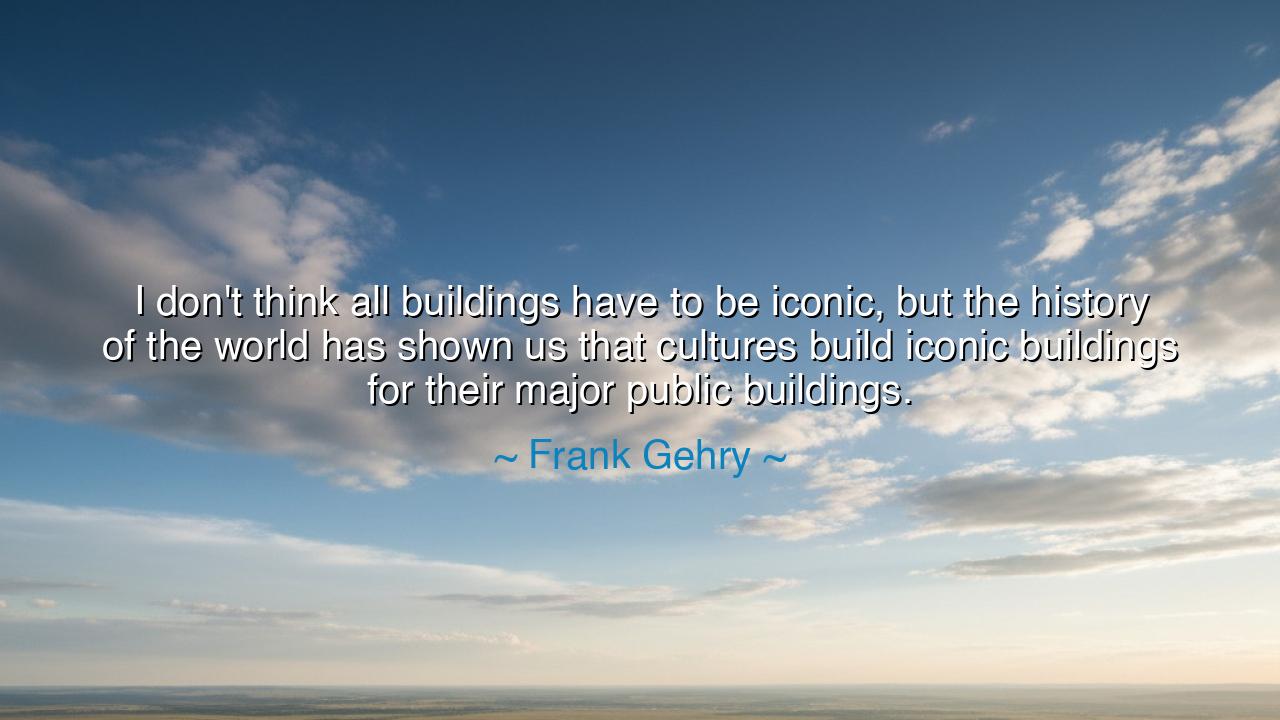
I don't think all buildings have to be iconic, but the history of
I don't think all buildings have to be iconic, but the history of the world has shown us that cultures build iconic buildings for their major public buildings.






“I don’t think all buildings have to be iconic, but the history of the world has shown us that cultures build iconic buildings for their major public buildings.” Thus spoke Frank Gehry, the master of form and movement, whose architecture bends steel and light into poetry. In these words lies a truth that reaches beyond design itself—a meditation on culture, memory, and the human need to give shape to what it reveres. Gehry reminds us that architecture is not only shelter; it is symbol, the material reflection of a people’s spirit. While not every structure must aspire to greatness, he says, there are moments in history when civilizations rise to declare themselves—and they do so through iconic buildings, monuments that speak across generations.
To understand his meaning, we must first see that Gehry’s view of architecture is not rooted in vanity or spectacle, but in purpose. The word “iconic” does not mean extravagant—it means meaningful. It is not the architect’s ego that makes a building iconic, but the alignment of vision, craft, and cultural will. When Gehry designed the Guggenheim Museum Bilbao, it was not merely a museum—it was a resurrection. Bilbao, once a fading industrial city, found new life through a building that became its emblem. The curves of titanium reflected not just light, but the rebirth of identity. Gehry’s statement, therefore, is both humble and profound: not every creation must be monumental, but every culture must have monuments that mirror its soul.
From the dawn of civilization, humanity has sought to express its ideals in stone, wood, and light. The Pyramids of Egypt, rising against the desert’s silence, were not mere tombs—they were messages to eternity, declarations of divine order and human ambition. The Parthenon in Athens, perfect in proportion, stood not only as a temple to Athena but as a hymn to reason and democracy. The Gothic cathedrals of medieval Europe reached upward like prayers carved in stone, embodying the collective yearning of an age that sought heaven through artistry. Each of these buildings was iconic, not because they dominated the skyline, but because they embodied belief—the invisible made visible through the labor of human hands.
Yet Gehry, in his wisdom, acknowledges that not all buildings must bear such weight. The humblest structures—homes, schools, markets—form the fabric of daily life and need not dazzle the eye to serve their purpose. There is beauty, too, in simplicity. But when a people comes together to create a public work, something that belongs to all and represents all, it must aspire to the extraordinary. For in these shared spaces, architecture becomes memory, and memory becomes legacy. To build an iconic building is to declare to the future, “We were here. We believed. We dreamed.”
Consider also the lesson of the United States Capitol, a building conceived in the turbulent infancy of a nation. Its dome, rising over Washington D.C., is not merely a feat of engineering—it is a symbol of unity, a visual promise of democracy’s endurance. Like the great forums of Rome or the temples of Kyoto, it transcends function. It gathers meaning, layer by layer, as history unfolds around it. When Gehry speaks of “major public buildings,” he is invoking this ancient pattern: that the architecture of a people’s public life reveals the architecture of its soul.
But Gehry’s insight carries another, subtler warning. In an age of haste and spectacle, many pursue “iconic” design for its own sake, mistaking novelty for meaning. True iconicity cannot be forced—it must arise naturally from a union of place, purpose, and imagination. The Taj Mahal was not built to impress, but to mourn and immortalize love; its grandeur flowed from sincerity. The greatest architecture does not shout—it endures. It is born from patience, vision, and faith in the lasting power of form to move the human heart.
Therefore, let Gehry’s words be a reminder to builders of every kind—architects of stone and architects of destiny alike. Not all your works need be monuments, but when you create for the public, when your work will stand before the eyes of generations, build with meaning. Do not seek fame; seek truth. Do not chase extravagance; pursue harmony between purpose and beauty. For long after names are forgotten, buildings remain as voices of their time—whispering the story of who we were, and what we held sacred.
And so, the lesson endures: civilizations are not remembered by their wealth, but by what they choose to make eternal. The iconic building is not a structure alone—it is a mirror of humanity’s highest aspirations. Let every creator, in whatever craft they labor, remember this: that what we build today—whether in stone, word, or deed—becomes the monument of tomorrow. Build, therefore, not for applause, but for immortality.






AAdministratorAdministrator
Welcome, honored guests. Please leave a comment, we will respond soon